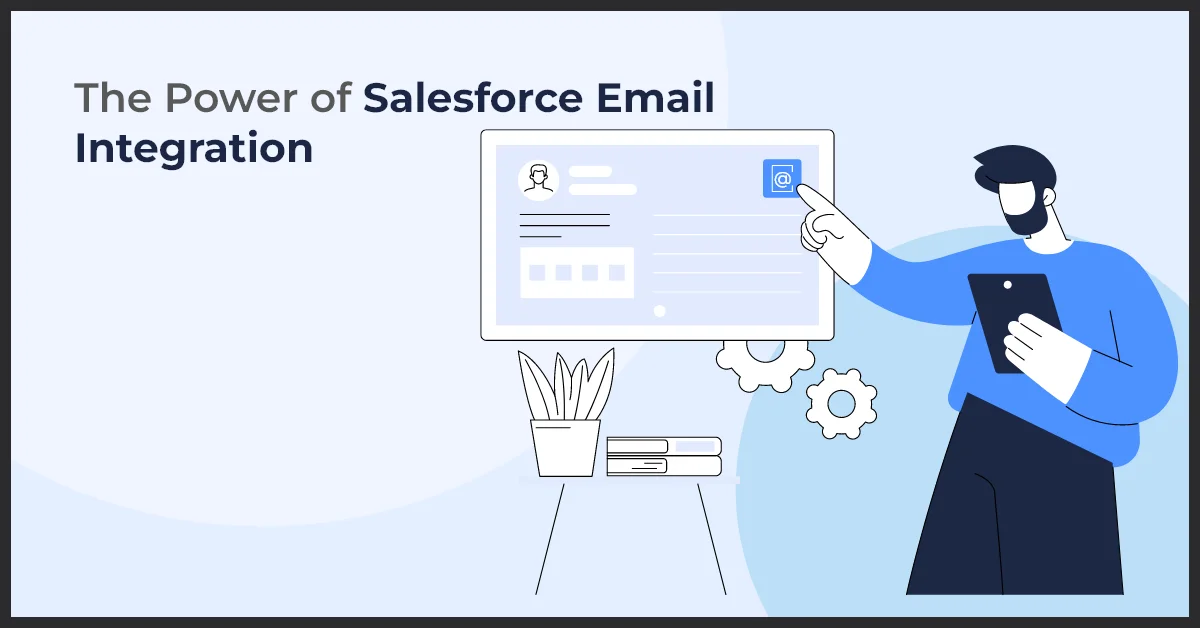The Power of Salesforce Email Integration

Published on: November 2, 2023
Updated on: September 11, 2024
1887 Views
- Salesforce
12 min read
Are you looking for a game-changing tool to elevate your marketing efforts? Look no further! Salesforce Email Integration is here to revolutionize the way you engage with your audience and drive sales. In this article, we will explore the significance of Salesforce Email, its role in modern marketing, and how Salesforce seamlessly integrates with email service providers.
Overview of Salesforce Email and its significance
Salesforce Email is a powerful tool that allows you to create, send, and track customized email campaigns effortlessly. It enables you to build a strong relationship with your customers, nurture leads, and drive conversions. With Salesforce Email, you have access to advanced analytics and insights, allowing you to make data-driven decisions and optimize your marketing strategies.
The role of email in modern marketing
In today's digital world, email remains an essential channel in marketing. It provides a direct pathway to reach your target audience and deliver personalized messages. Email marketing enables you to build brand loyalty, showcase new products or services, promote special offers, and engage customers in meaningful conversations. By harnessing the power of email, you can nurture leads, drive repeat purchases, and ultimately boost your ROI.
How Salesforce integrates with email service providers
Salesforce seamlessly integrates with various email service providers, such as MailChimp, Constant Contact, and SendGrid, among others. Salesforce integration allows you to synchronize your contact lists, automate email campaigns, and track customer interactions within the Salesforce platform. By integrating Salesforce with your email service provider, you can streamline your marketing efforts, enhance productivity, and gain a comprehensive view of your customer's journey.
Don't miss out on the incredible potential of Salesforce Email Integration. Embrace this transformative tool today and witness the exponential growth of your marketing success. Get started with Salesforce today and take your email marketing game to new heights!
Understanding Salesforce Email Marketing
A. Exploring the basics of email marketing
Email marketing is a crucial tool for businesses to engage with their audience and drive results. It involves sending commercial messages to a group of people using electronic mail. This approach allows companies to directly communicate with their customers, build brand loyalty, and generate sales.
One of the main benefits of email marketing is its cost-effectiveness. Compared to traditional marketing channels, such as print or TV ads, email marketing is relatively inexpensive. It also enables businesses to reach a large number of people at once and target specific demographics or customer segments.
B. Overview of Salesforce Marketing Cloud
Salesforce Marketing Cloud is a comprehensive platform that helps businesses create and manage their email marketing campaigns. It offers a wide range of features and functionalities designed to enhance and optimize email marketing strategies.
Some of the key features of Salesforce Marketing Cloud include personalized email automation, segmentation tools, A/B testing capabilities, and advanced analytics. These features empower businesses to deliver relevant and targeted email campaigns, resulting in higher engagement and conversions.
C. Leveraging automated email campaigns
Automated email campaigns are a powerful tool in email marketing. They allow businesses to send out personalized and timely messages to their customers based on predefined triggers or actions.
By leveraging automated email campaigns, businesses can save time and resources while maintaining consistent communication with their audience. It also enables them to nurture leads, provide relevant content, and drive conversions.
When implementing automated email campaigns, it is essential to follow some best practices. These include segmenting your audience, using personalized content, optimizing email templates for various devices, and regularly monitoring and analyzing campaign performance.
Salesforce Email Studio is an integral part of Salesforce Marketing Cloud that facilitates the creation, management, and deployment of email campaigns. With its user-friendly interface and robust features, businesses can easily design and send impactful emails to their target audience.
To enhance email performance and increase engagement, Salesforce offers various tools and features. These include personalization options, advanced reporting and analytics, dynamic content, and integration with other Salesforce products.
By leveraging these features and following best practices, businesses can optimize their email marketing efforts and achieve measurable results.
D. Salesforce Email Best Practices
- Segment your audience based on demographics, preferences, or previous interactions.
- Create personalized and relevant content tailored to each segment.
- Optimize email templates for different devices to ensure a seamless user experience.
- Regularly monitor and analyze campaign performance to make data-driven decisions.
E. Click Tracking and Optimization
Click tracking is an essential feature in email marketing that allows businesses to track and measure the effectiveness of their call-to-action buttons and links. By analyzing click-through rates, businesses can gain insights into their audience's preferences, optimize their emails, and improve conversion rates.
Optimization is an ongoing process in email marketing. It involves continuously refining and improving email campaigns based on performance data and customer feedback. By testing different elements, such as subject lines, content, and layout, businesses can identify what resonates best with their audience and adapt their strategies accordingly.
F. Conclusion
Salesforce Email Marketing offers businesses a powerful and efficient way to connect with their audience, drive engagement, and achieve their marketing goals. By leveraging the features and functionalities provided by Salesforce Marketing Cloud and following best practices, businesses can optimize their email marketing strategies and generate significant results.
Utilizing Salesforce Email Studio
A. Introduction to Salesforce Email Studio
Salesforce Email Studio is a powerful tool that enables businesses to streamline their email marketing efforts and enhance customer communication. With an array of features and capabilities, Salesforce Email Studio allows you to create, manage, and optimize email campaigns effectively.
1. Key features and capabilities
One of the key features of Salesforce Email Studio is its ability to create personalized email campaigns at scale. With dynamic content and targeted audience segmentation, you can deliver highly relevant and engaging emails to your customers. Additionally, the tool provides a drag-and-drop interface, making it easy to design visually appealing templates without any coding.
Furthermore, Salesforce Email Studio offers comprehensive tracking and reporting capabilities. You can track email opens, clicks, and conversions, allowing you to measure the success of your campaigns and optimize them for better performance.
B. Creating and managing email templates
Creating email templates is crucial for maintaining consistent branding across your email campaigns. With Salesforce Email Studio, you can design and manage custom templates effortlessly.
1. Importance of templates for consistent branding
Using consistent templates ensures that your brand identity is reflected in every email you send. It helps in building brand recognition and trust among your subscribers. Salesforce Email Studio provides a user-friendly template builder that allows you to customize your templates with your brand colors, logos, and fonts.
2. Best practices for designing effective email templates
To design effective email templates, it's essential to follow best practices that maximize engagement and conversions. Some best practices include using a clear and compelling subject line, incorporating a single call-to-action, optimizing for mobile devices, and keeping the design simple and visually appealing.
C. Integrating Salesforce with Email
Integrating Salesforce with your email marketing platform brings numerous benefits to your business.
1. Benefits of Salesforce Email Integration
By integrating Salesforce with your email platform, you can easily synchronize customer data, create targeted lists, and automate personalized email campaigns. This integration ensures that your marketing efforts are aligned with your sales and customer service teams, providing a seamless experience to your customers.
2. How it improves customer communication and service
Integrating Salesforce with your email platform enables you to have a comprehensive view of your customer interactions and preferences. This information helps you tailor your email content to align with their interests and engage them effectively. Moreover, it allows your sales and customer service teams to have a holistic understanding of customer interactions, enhancing their ability to provide personalized assistance and support.
Enhancing Email Performance with Salesforce
A. Tracking email metrics and analytics
1. Importance of email tracking in evaluating campaign success
Tracking the performance of your email campaigns is crucial for evaluating their success and making data-driven decisions. Salesforce provides robust tools for tracking and analyzing various metrics to understand the effectiveness of your email marketing efforts.
2. Key metrics to monitor for improved performance
By monitoring key metrics such as open rates, click-through rates, bounce rates, and conversion rates, you can gain insights into how recipients engage with your emails. This information allows you to identify areas of improvement and optimize your email campaigns for better performance.
B. Maximizing email deliverability in Salesforce
1. Understanding factors that affect deliverability
In order to ensure your emails reach your recipients' inboxes, it's important to understand the factors that can affect email deliverability. Factors such as sender reputation, email content, and the quality of your subscriber list can impact whether your emails land in the inbox or get filtered into spam folders.
2. Strategies for improving email deliverability
Salesforce provides features and best practices that can help you improve email deliverability. These include using double opt-in for subscription, personalizing your emails, segmenting your subscriber list, regularly cleaning your list, and adhering to anti-spam guidelines.
Salesforce Email Best Practices
A. Personalizing email communication
Personalized emails are crucial for effective customer engagement. When emails are tailored to individual recipients, they feel more valued and are more likely to take action. Salesforce offers various tools and features to help you achieve effective personalization:
- Segmentation: Utilize Salesforce's segmentation capabilities to categorize customers based on their preferences, behaviors, or demographics. This allows you to create targeted email campaigns.
- Dynamic Content: Use dynamic content blocks in Salesforce Email Studio to display personalized content based on customer data. This ensures that each recipient receives relevant information.
- Personalization Tokens: Salesforce allows you to insert personalized tokens, such as the recipient's name or past purchase history, into your email content. This adds a personal touch to your emails.
B. Leveraging customer data for targeted emails
Utilizing customer data is essential in creating targeted and impactful email campaigns. Salesforce provides powerful tools to leverage your customer data effectively:
- Customer Insights: Analyze customer data stored in Salesforce to understand their preferences, buying patterns, and communication preferences. This enables you to send relevant and timely emails.
- Automation: Automate email campaigns based on specific triggers or customer actions. Salesforce's automation features allow you to deliver personalized emails at the right moment.
- Integration: Connect Salesforce with other data sources to gather comprehensive customer information. This integration ensures that you have a holistic view of your customers and can create highly targeted emails.
C. Implementing best practices for product-focused emails
Product-focused emails are an effective way to promote your offerings and drive conversions. Follow these best practices when leveraging Salesforce for product-focused emails:
- Compelling Subject Lines: Craft attention-grabbing subject lines that entice recipients to open your emails. A well-written subject line can significantly increase open rates.
- Engaging Content: Use persuasive and concise content to highlight the benefits and features of your products. Incorporate visuals, such as product images or videos, to make your emails more engaging.
- Call-to-Action (CTA): Include clear and prominent CTAs that direct recipients to take the desired action. Use compelling language to encourage click-throughs and conversions.
- A/B Testing: Experiment with different email elements, such as subject lines, content, or CTAs, using Salesforce's A/B testing feature. This helps you identify the most effective strategies for product-focused emails.
Click Tracking and Optimization
A. Importance of click tracking in email marketing
Click tracking is a crucial component of email marketing as it provides valuable insights into user engagement and behavior. By tracking the clicks, you can determine which links are generating the most interest and conversions. This data enables you to make data-driven decisions to optimize your email campaigns for better results.
B. Utilizing Salesforce for tracking clicks in emails
With Salesforce, tracking clicks in emails becomes a seamless process. Salesforce Email Studio offers robust tracking capabilities, allowing you to monitor click-through rates, analyze individual email performance, and gain a complete understanding of user engagement with your email campaigns. By leveraging Salesforce's click tracking features, you can streamline your email marketing strategies and drive more conversions.
C. Strategies for optimizing click-through rates
- Compelling Call-to-Action (CTA): Craft clear and persuasive CTAs that encourage recipients to click through. Use strong action words, create a sense of urgency, and highlight the benefits of clicking on the link.
- Personalization: Tailor your emails to individual recipients by leveraging Salesforce's personalization capabilities. Addressing recipients by name and delivering personalized content relevant to their interests can significantly improve click-through rates.
- A/B Testing: Experiment with different elements of your emails, such as subject lines, CTAs, and email layouts, using Salesforce's A/B testing feature. By measuring the performance of different variations, you can identify the best-performing elements and optimize your emails accordingly.
- Mobile Optimization: With the increasing number of users accessing emails on mobile devices, it is crucial to optimize your email designs for mobile responsiveness. Create mobile-friendly emails that offer a seamless experience and make it easy for recipients to click through.
- Segmentation: Utilize Salesforce's segmentation capabilities to target specific groups of recipients with tailored messages and offers. By delivering relevant content to the right audience, you can increase the chances of recipients clicking through.
By implementing these strategies and leveraging Salesforce's click tracking features, you can enhance your email marketing campaigns, improve click-through rates, and drive greater conversions.
Conclusion
In conclusion, this article has provided a comprehensive overview of Salesforce Email and its various features and best practices. It is clear that Salesforce Email plays a crucial role in modern marketing strategies. The ability to target and engage customers through personalized and automated email campaigns is invaluable in today's digital landscape.
We highly emphasize the importance of Salesforce Email in driving customer engagement and generating leads. It offers powerful tools and capabilities that can help businesses stay competitive and achieve their marketing goals.
For those seeking to maximize their marketing efforts, further exploration and implementation of Salesforce Email is highly recommended. By utilizing the features and following the best practices discussed in this article, businesses can unlock the full potential of their email marketing strategies and drive impactful results.
Remember, Salesforce Email is just one component of the larger Salesforce ecosystem, offering a range of solutions to support businesses across various marketing channels and touchpoints. By integrating Salesforce Email with other Salesforce products, businesses can create a cohesive and comprehensive marketing strategy that delivers exceptional results.
We hope this article has provided valuable insights and guidance in harnessing the power of Salesforce Email for your marketing efforts. Happy emailing!
Frequently Asked Questions
Salesforce email integration connects your email platform (e.g., Gmail, Outlook) with Salesforce, enabling seamless communication, tracking, and management of emails directly within the Salesforce CRM.
Salesforce email integration works by syncing emails between your email client and Salesforce, allowing users to send, receive, and log emails, track interactions, and access customer data from Salesforce without switching platforms.
Benefits include centralized communication, improved productivity, better visibility into customer interactions, automated email logging, enhanced collaboration, and streamlined workflows that provide a 360-degree view of customer relationships.
Email integration improves customer communication by tracking all interactions in real-time, providing personalized and timely responses, enhancing team collaboration, and enabling more informed, context-driven conversations with customers.
Common challenges include ensuring proper setup and configuration, maintaining data accuracy, managing email storage limits, syncing issues between platforms, and ensuring email data security during integration.



